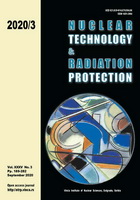
REACTIVITY INSERTION ACCIDENT ANALYSIS DURING URANIUM FOIL TARGET IRRADIATION IN THE RSG-GAS REACTOR CORE

Vol.
XXXV, No. 3, Pp. 189-282
September 2020
UDC 621.039+614.876:504.06
ISSN 1451-3994
Pages: 201-207
Authors: Surian Pinem, Tagor Malem Sembiring, and Tukiran SurbaktiAbstract
Analysis of the steady-state and reactivity insertion accident is very important for the safety of reactor operations. In this study, steady-state and reactivity insertion accident analysis when the low enriched uranium foil target is irradiated in the reactor core has been carried out. The analysis is carried out by the best estimate method by using a coupled neutronic, kinetic, and thermal-hydraulic code, MTR-DYN. The MTR-DYN code is based on the 3-D multigroup neutron diffusion method. The cell calculations for the target are carried out by the WIMSD/5 and MTR-DYN code. After reactivity insertion, the coolant, fuel, and clad temperature are observed. The calculation results for the initial power of 1 W showed that the maximum temperature of the coolant, clad, and fuel are 49.76 °C, 65.01 °C, and 65.26 °C, respectively. Meanwhile, when the reactivity insertion at the initial power of 1 MW, the maximum temperature of the coolant, clad, and fuel are 72.23 °C, 140.79 °C, and 141.97 °C, respectively. Based on those calculation results during irradiation low enriched uranium foil target, the temperature in the steady-state and reactivity insertion accident does not exceed the allowable safety limit.
Key words: reactivity insertion analysis, safety limit, low enrichment uranium foil, MTR-DYN code
FULL PAPER IN PDF FORMAT (1,02 MB)